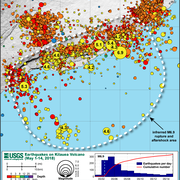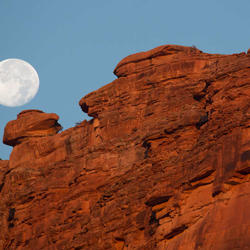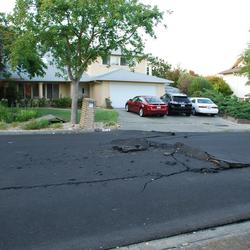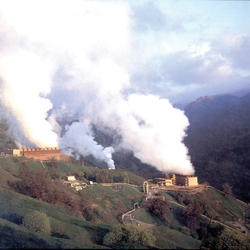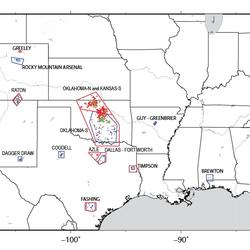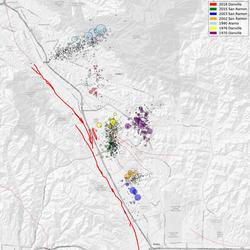During the 2016 BioBlitz at Bandelier National Monument, members of the New Mexico Landscapes Field Station presented fire history information which intrigued these young students.
Where can I find earthquake educational materials?
Start with our Earthquake Hazards Education site. That includes:
Other good starting points include:
- State Geological Surveys for states in earthquake-prone regions
- The Great ShakeOut Earthquake Drills website
- SAGE (Seismological Facility for the Advancement of Geoscience), which is a non-profit consortium
Related
What is an earthquake and what causes them to happen?
An earthquake is caused by a sudden slip on a fault. The tectonic plates are always slowly moving, but they get stuck at their edges due to friction. When the stress on the edge overcomes the friction, there is an earthquake that releases energy in waves that travel through the earth's crust and cause the shaking that we feel. In California there are two plates - the Pacific Plate and the North...
Foreshocks, aftershocks - what's the difference?
"Foreshock" and "aftershock" are relative terms. Foreshocks are earthquakes that precede larger earthquakes in the same location. An earthquake cannot be identified as a foreshock until after a larger earthquake in the same area occurs. Aftershocks are smaller earthquakes that occur in the same general area during the days to years following a larger event or "mainshock." They occur within 1-2...
Can the position of the moon or the planets affect seismicity? Are there more earthquakes in the morning/in the evening/at a certain time of the month?
Earthquakes are equally as likely to occur in the morning or the evening. Many studies in the past have shown no significant correlations between the rate of earthquake occurrence and the semi-diurnal tides when using large earthquake catalogs. Several recent studies, however, have found a correlation between earth tides (caused by the position of the moon relative to the earth) and some types of...
What is surface faulting or surface rupture in an earthquake?
Surface rupture occurs when movement on a fault deep within the earth breaks through to the surface. NOT ALL earthquakes result in surface rupture.
At what depth do earthquakes occur? What is the significance of the depth?
Earthquakes occur in the crust or upper mantle, which ranges from the earth's surface to about 800 kilometers deep (about 500 miles). The strength of shaking from an earthquake diminishes with increasing distance from the earthquake's source, so the strength of shaking at the surface from an earthquake that occurs at 500 km deep is considerably less than if the same earthquake had occurred at 20...
Why are there so many earthquakes in the Geysers area in Northern California?
The Geysers Geothermal Field is located in a tectonically active region of Northern California. The major seismic hazards in the region are from large earthquakes occurring along regional faults that are located miles away from the geothermal field, such as the San Andreas and Healdsburg-Rodgers Creek faults. However, activities associated with the withdrawal of steam for producing electric power...
Do earthquakes occur in Antarctica?
Earthquakes do occur in Antarctica, but not very often. There have been some big earthquakes--including one magnitude 8.1 --in the Balleny Islands (between Antarctica and New Zealand). The boundary between the Scotia Plate and the Antarctic Plate just grazes the north tip of the Antarctic Peninsula (look "northwest" from the Pole toward South America). There is also a hint of a line of seismicity...
Where can I find earthquake educational materials?
Start with our Earthquake Hazards Education site. That includes: Earthquakes for Kids Cool Earthquake Facts Earthquake Science for Everyone Other good starting points include: State Geological Surveys for states in earthquake-prone regions The Great ShakeOut Earthquake Drills website SAGE (Seismological Facility for the Advancement of Geoscience), which is a non-profit consortium
Can we cause earthquakes? Is there any way to prevent earthquakes?
Earthquakes induced by human activity have been documented at many locations in the United States and in many other countries around the world. Earthquakes can be induced by a wide range of causes including impoundment of reservoirs, surface and underground mining, withdrawal of fluids and gas from the subsurface, and injection of fluids into underground formations. While most induced earthquakes...
What is the difference between aftershocks and swarms?
Aftershocks are a sequence of earthquakes that happen after a larger mainshock on a fault. Aftershocks occur near the fault zone where the mainshock rupture occurred and are part of the "readjustment process” after the main slip on the fault. Aftershocks become less frequent with time, although they can continue for days, weeks, months, or even years for a very large mainshock. A swarm, on the...
During the 2016 BioBlitz at Bandelier National Monument, members of the New Mexico Landscapes Field Station presented fire history information which intrigued these young students.
Following the devastating 2010 Haiti earthquake, the USGS has been helping with earthquake awareness and monitoring in the country, with continued support from the U.S. Agency for International Development (USAID).
Following the devastating 2010 Haiti earthquake, the USGS has been helping with earthquake awareness and monitoring in the country, with continued support from the U.S. Agency for International Development (USAID).
Students participate in the Great Southeast ShakeOut earthquake drill at Langston Hughes Middle School in Reston, Virginia. They are conducting the "drop, cover and hold on" safety procedure.
Students participate in the Great Southeast ShakeOut earthquake drill at Langston Hughes Middle School in Reston, Virginia. They are conducting the "drop, cover and hold on" safety procedure.

USGS seismologist Luke Blair demonstrates an earthquake animation to students during an Earth Science Week event at the USGS in Menlo Park.
USGS seismologist Luke Blair demonstrates an earthquake animation to students during an Earth Science Week event at the USGS in Menlo Park.
What if you knew that a magnitude 7.8 earthquake would happen in less than three weeks?
In this video interview, USGS earthquake scientist Dr. Lucy Jones explains that millions of Southern Californians will be preparing as if they do know, thanks to the Great Southern California ShakeOut.
What if you knew that a magnitude 7.8 earthquake would happen in less than three weeks?
In this video interview, USGS earthquake scientist Dr. Lucy Jones explains that millions of Southern Californians will be preparing as if they do know, thanks to the Great Southern California ShakeOut.
Listen to hear the answer.
Following the devastating 2010 Haiti earthquake, the USGS has been helping with earthquake awareness and monitoring in the country, with continued support from the U.S. Agency for International Development (USAID).
Following the devastating 2010 Haiti earthquake, the USGS has been helping with earthquake awareness and monitoring in the country, with continued support from the U.S. Agency for International Development (USAID).
Comparison of earthquake early warning systems and the national volcano early warning system at the U.S. Geological Survey
Natural Hazards Science at the U.S. Geological Survey
Putting down roots in earthquake country: Your handbook for earthquakes in the Central United States
The ShakeOut Scenario
Putting down roots in earthquake country: Your handbook for the San Francisco Bay region
The USGS Earthquake Hazards Program - investing in a safer future
Quaternary fault and fold database of the United States
Earthquake damage to schools
Related
What is an earthquake and what causes them to happen?
An earthquake is caused by a sudden slip on a fault. The tectonic plates are always slowly moving, but they get stuck at their edges due to friction. When the stress on the edge overcomes the friction, there is an earthquake that releases energy in waves that travel through the earth's crust and cause the shaking that we feel. In California there are two plates - the Pacific Plate and the North...
Foreshocks, aftershocks - what's the difference?
"Foreshock" and "aftershock" are relative terms. Foreshocks are earthquakes that precede larger earthquakes in the same location. An earthquake cannot be identified as a foreshock until after a larger earthquake in the same area occurs. Aftershocks are smaller earthquakes that occur in the same general area during the days to years following a larger event or "mainshock." They occur within 1-2...
Can the position of the moon or the planets affect seismicity? Are there more earthquakes in the morning/in the evening/at a certain time of the month?
Earthquakes are equally as likely to occur in the morning or the evening. Many studies in the past have shown no significant correlations between the rate of earthquake occurrence and the semi-diurnal tides when using large earthquake catalogs. Several recent studies, however, have found a correlation between earth tides (caused by the position of the moon relative to the earth) and some types of...
What is surface faulting or surface rupture in an earthquake?
Surface rupture occurs when movement on a fault deep within the earth breaks through to the surface. NOT ALL earthquakes result in surface rupture.
At what depth do earthquakes occur? What is the significance of the depth?
Earthquakes occur in the crust or upper mantle, which ranges from the earth's surface to about 800 kilometers deep (about 500 miles). The strength of shaking from an earthquake diminishes with increasing distance from the earthquake's source, so the strength of shaking at the surface from an earthquake that occurs at 500 km deep is considerably less than if the same earthquake had occurred at 20...
Why are there so many earthquakes in the Geysers area in Northern California?
The Geysers Geothermal Field is located in a tectonically active region of Northern California. The major seismic hazards in the region are from large earthquakes occurring along regional faults that are located miles away from the geothermal field, such as the San Andreas and Healdsburg-Rodgers Creek faults. However, activities associated with the withdrawal of steam for producing electric power...
Do earthquakes occur in Antarctica?
Earthquakes do occur in Antarctica, but not very often. There have been some big earthquakes--including one magnitude 8.1 --in the Balleny Islands (between Antarctica and New Zealand). The boundary between the Scotia Plate and the Antarctic Plate just grazes the north tip of the Antarctic Peninsula (look "northwest" from the Pole toward South America). There is also a hint of a line of seismicity...
Where can I find earthquake educational materials?
Start with our Earthquake Hazards Education site. That includes: Earthquakes for Kids Cool Earthquake Facts Earthquake Science for Everyone Other good starting points include: State Geological Surveys for states in earthquake-prone regions The Great ShakeOut Earthquake Drills website SAGE (Seismological Facility for the Advancement of Geoscience), which is a non-profit consortium
Can we cause earthquakes? Is there any way to prevent earthquakes?
Earthquakes induced by human activity have been documented at many locations in the United States and in many other countries around the world. Earthquakes can be induced by a wide range of causes including impoundment of reservoirs, surface and underground mining, withdrawal of fluids and gas from the subsurface, and injection of fluids into underground formations. While most induced earthquakes...
What is the difference between aftershocks and swarms?
Aftershocks are a sequence of earthquakes that happen after a larger mainshock on a fault. Aftershocks occur near the fault zone where the mainshock rupture occurred and are part of the "readjustment process” after the main slip on the fault. Aftershocks become less frequent with time, although they can continue for days, weeks, months, or even years for a very large mainshock. A swarm, on the...
During the 2016 BioBlitz at Bandelier National Monument, members of the New Mexico Landscapes Field Station presented fire history information which intrigued these young students.
During the 2016 BioBlitz at Bandelier National Monument, members of the New Mexico Landscapes Field Station presented fire history information which intrigued these young students.
Following the devastating 2010 Haiti earthquake, the USGS has been helping with earthquake awareness and monitoring in the country, with continued support from the U.S. Agency for International Development (USAID).
Following the devastating 2010 Haiti earthquake, the USGS has been helping with earthquake awareness and monitoring in the country, with continued support from the U.S. Agency for International Development (USAID).
Students participate in the Great Southeast ShakeOut earthquake drill at Langston Hughes Middle School in Reston, Virginia. They are conducting the "drop, cover and hold on" safety procedure.
Students participate in the Great Southeast ShakeOut earthquake drill at Langston Hughes Middle School in Reston, Virginia. They are conducting the "drop, cover and hold on" safety procedure.

USGS seismologist Luke Blair demonstrates an earthquake animation to students during an Earth Science Week event at the USGS in Menlo Park.
USGS seismologist Luke Blair demonstrates an earthquake animation to students during an Earth Science Week event at the USGS in Menlo Park.
What if you knew that a magnitude 7.8 earthquake would happen in less than three weeks?
In this video interview, USGS earthquake scientist Dr. Lucy Jones explains that millions of Southern Californians will be preparing as if they do know, thanks to the Great Southern California ShakeOut.
What if you knew that a magnitude 7.8 earthquake would happen in less than three weeks?
In this video interview, USGS earthquake scientist Dr. Lucy Jones explains that millions of Southern Californians will be preparing as if they do know, thanks to the Great Southern California ShakeOut.
Listen to hear the answer.
Following the devastating 2010 Haiti earthquake, the USGS has been helping with earthquake awareness and monitoring in the country, with continued support from the U.S. Agency for International Development (USAID).
Following the devastating 2010 Haiti earthquake, the USGS has been helping with earthquake awareness and monitoring in the country, with continued support from the U.S. Agency for International Development (USAID).



